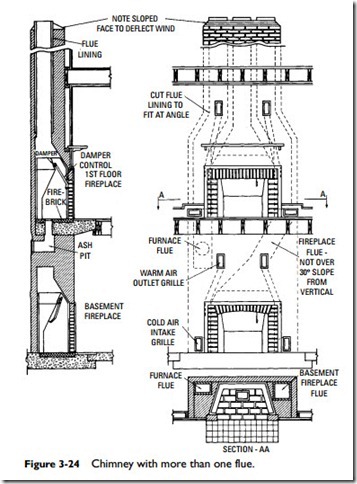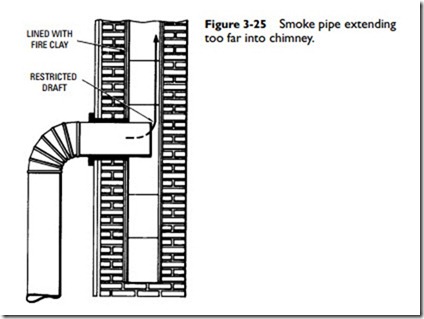Chimney Flues and Chimney Liners
The chimney flue is the passage through which the smoke, gases, and other products of the combustion process travel to the out- doors. A chimney liner (sometimes called a flue liner or flue lining) is a metal tube inserted into the chimney to protect its walls against the potentially damaging gases of the combustion process. It is also used to size the diameter of the chimney flue opening for different appliances. The chimney liner must be code-approved for use in chimneys. Aluminum chimney liners are recommended for use with gas appliances.
Although most flues are lined with a fireproof material, chimneys with walls 8 inches or more in thickness do not need a flue lining. Fired-clay linings are used for flues in chimneys having walls less than 8 inches thick. Chimneys without a flue lining should be carefully pargeted and troweled so that the surface is as smooth as possible.
Flue construction is very important. If the flue is too small, it will restrict the passage and slow the rise of the flue gases. A flue that is too large will cause the fireplace to smoke when the fire is first started. Because the flue is too large, the fire takes longer to heat the air, and consequently the flue gases are initially slow to overcome the heavy cold air found in the chimney.
If the same chimney is used to serve fireplaces on two or more floors, each fireplace should have a separate flue (see Figure 3-24). This also holds true when a furnace (or boiler) and one or more fireplaces use the same chimney. Each heat source should be con- nected to a separate flue in the chimney.
Do not allow two (or more) flues to end on the same level at the top of the chimney. Doing so can result in smoke or gases from one flue being drawn down into the other one. One of the flues should be at least 6 inches higher than the other.
Smoke Pipe
The smoke pipe is used to connect the heating equipment to the chimney flue. Never allow the smoke pipe to extend beyond the flue lining in the chimney or it will obstruct the flow of smoke and other gases (see Figures 3-25 and 3-26).
Cleanout Trap
Chimneys used with coal-fired and oil-fired heating equipment should be equipped with cleanout traps. Access is provided in the ashpit (see Figure 3-4).


